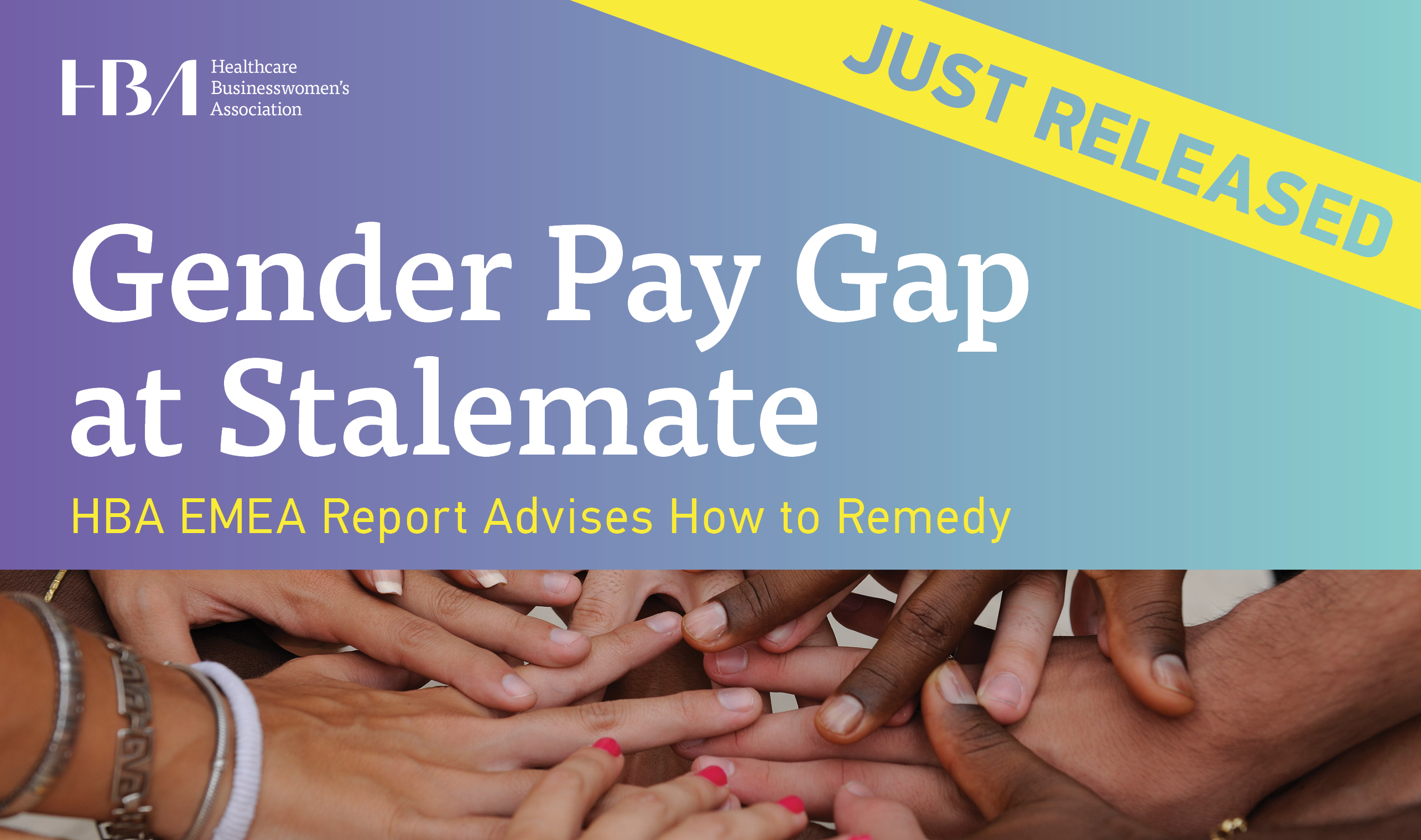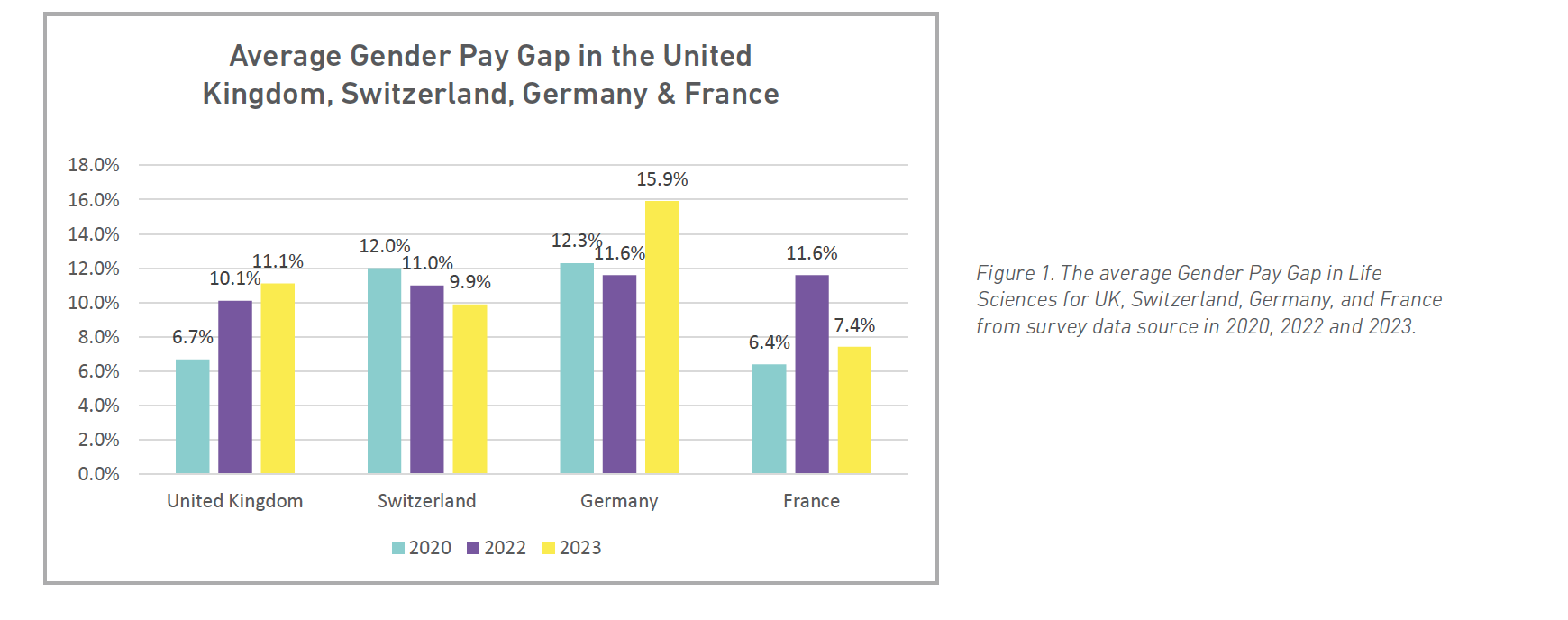Gender Pay Gap Snapshot 2024

A report from the Healthcare Businesswomen’s Association Europe, Middle East, Africa (EMEA) Region, in collaboration with Aon
Authors: Lauren Alani, Marcus Ngantcha, Alessandro Linari, Sean Yap, Kai Siekmeier
Gender Pay Gap in Europe’s Life Sciences at Stalemate
In the six years, the HBA has been collaborating with Aon and reporting on the gender pay gap in life sciences across Europe, we have seen very little overall change. There has been a constant fluctuation between 11 and 14.4 percent, and currently we are seeing an average gender pay gap of 12.3 percent.
However, there is a ray of light with the 2023 survey data showing a reduction in the pay gap since our last report, published in March 2023. This news comes against a backdrop of an increasing number of articles highlighting the polarisation between women and men (1,2) and the rise in followers for influencers accused of sexist and misogynistic behaviour(3).
The increase in polarisation can feel frightening and seem an almost impossible problem to solve. On this topic, the following valuable advice came from a panel of industry leaders, Victoria Kent, James Read, Susan Rienow, Seyda Atadan Memis, Valerie Phillips, and Paula Sheridan, hosted by the London Chapter at Syneos Health on 12th April 2024.
Experts Advise on Gender Polarization, Closing the Stalemate and the Gender Pay Gap
- Long-term: It takes time to change the views of a community. The majority of people want to do the right thing so, instead of being sucked into the fast pace and hard-hitting headlines which are often written in a way to elevate tensions and emotions to drive readership and “clickbait,” we need to consider the long-term impact of how we are raising the next generation.
- Social media: We are getting better at understanding and enforcing better physical behaviours, e.g., the rise in protections for street harassment(4), but for some reason we have not yet determined how to protect people online. I would add that it is critical we continue to learn how to better assess the validity of the information we read so that we are more able to determine truth from biases, opinions, or outright manipulation.
- Leadership: Be clear about expected behaviours and speak out. It is also important that the execution of changes that are made to ensure equitability in the workplace are communicated in an equitable way. For example, changing new job descriptions to gender neutral language is not to ensure we place more women in senior roles, but to ensure the best person gets the job, which will naturally see more diverse leadership teams.
- Parental leave: Men and women should have equal opportunity to raise their children, and this starts with parental leave policies. Sweden is often viewed as one of the most equitable countries, which may have begun almost 50 years ago when the government first launched its “use it or lose it” gender neutral state paid parental leave(5). This means that employees have equal likelihood of requiring the same period of leave, as a parent they each learn how to be the primary caregiver and what is needed which creates balance in the home, and children benefit from spending equal time with their parents from a young age.
To add another:
- Transparency: Encourage transparency of pay so that we can break down the barriers of misinformation and gain more insight on whether individuals are paid equally for equal work, to share criteria on what is needed to be promoted and to facilitate progressive discussions.
Above all else, we need organisations in life sciences to commit to actions that will drive positive change to ensure we continue the momentum to achieve equity. If we are to ensure we can meet our goals to positively impact human health, then we need to attract and retain key talent in our industry.
Currently, healthcare is in the bottom five industries, showing that we are amongst industries who have the worst gender pay gap(6) and that, while our female representation is notably high across the entire workforce, at 59 percent, we have a low representation of women in leadership, at 42 percent(7).
In addition to the points we have raised, we recommend organisations:
- Take stock of their current situation, understanding your current gender split and gender pay gap8,
- Ensure your company culture and policies appeal to a diverse audience(8),
- Use gender neutral and inclusive terminology(8),
- Take action to address pay discrepancies in your current workforce, to safeguard equal pay for equal work(9),
- Ensure your processes support equal likelihood of career progression.
Factors Maintaining the Gap
In this report we see that the gender pay gap is currently at 12.3 percent, which is a decrease from 14.5 percent reported last year. The largest contributors for the gender pay gap are level and function. “Level” addresses the representation gap, i.e., there are not enough women at the top. This causes a lack of balance across high paying roles, hampers the positive effect of role modelling, and means that there is a lack of women (note the plural, as opposed to having the sole tick box gender representative seat(9) having a voice at the table perpetuating decision bias.
Function is another major contributor because the typically lower paid job roles, such as HR and marketing, tend to attract a higher ratio of women. This could be driven by the wording used in job descriptions and/or the perceived requirement for soft skills being more highly regarded in these roles, which has traditionally been more valued by women.
Organisations could do well to consider the skills, both hard and soft, across their departments to ensure that there is a good weighting between functions that could be identified as similar work.
Anyone who has worked in sales will know that you cannot sell something without the right material, impactful messaging, and good understanding of your client base. Equally the skills required to master Search Engine Optimisation (SEO) and Google Ads (previously called AdWords) is high and this data driven approach can drive a significant increase in the number of leads generated, which directly increases the potential for business growth. Sales and marketing are very much interlinked and rely heavily on each other.
Equally HR and other executive leaders are required just as much as each other to ensure happy, healthy, and engaged employees that have a clear understanding of the vision of the organisation and believe in the values instilled in the carefully cultivated and (hopefully) supportive culture so that they are able to deliver to the best of their ability.
Two Up, Two Down
Gender pay gap in the United Kingdom is consistently increasing. The data suggests that when the market faces more uncertain economic conditions like in 2023, women’s careers in the UK are more greatly impacted than their male counterparts. Switzerland, on the other hand, does not seem to be impacted by these market dynamics and could be attributed to the Swiss labour market being more stable and tightly controlled than the UK. This means that the workforce is more shielded by adverse and transient market conditions. A smaller workforce employed in the life science industry may also have played a mitigating role.
Our figures for the gender pay gap in Germany show an increase by 4.3 percent and in France show a decrease by 4.2 percent, which are highly unusual and unexpected changes. We will need to continue monitoring the data to further understand this change. The data may indicate a change in the set of life science companies that were used to analyse these countries.
Clearly, there is something to learn from the experience of the UK and Switzerland. We encourage a reflection on what is working and what is not working in terms of female representation in these two countries, with a view of facilitating the lessons learned.

Taking Action to Drive Change
While it is positive news that the gender pay gap has decreased this year, in the years we have followed the gender pay gap we have seen a constant fluctuation between 11 and 14.4 percent. We encourage all life science organisations to reflect on how they will address inequalities driven by gender. More transparency around pay and workplace practices, commitment to action, and increased efforts to address polarisation is required to move forward towards a more equitable society.
To download this report please click here.
Methodology:
The data in this report has been taken from Aon’s Radford 2022 Full Census Global Compensation Database and contain information gathered from over 50,000 employees from over 180 companies across the life sciences sector in Europe.
The Methodology to calculate the Gender Pay Gaps is as follows:
Median Gender Pay Gap is based on Base Pay (excluding other fixed allowances)• Calculate Pay as the total of all fixed cash payments• Calculate the Median Pay for all Females• Calculate the Median Pay for all Males• The Median gender pay gap is (Male Median – Female Median) / Male Median
References and Footnotes:
1. https://www.economist.com/international/2024/03/13/why-the-growing-gulf-between-young-men-and-women
2. https://www.axios.com/2024/02/16/gen-z-gender-gap-political-left-women
3. https://inews.co.uk/news/andrew-tate-popular-young-fathers-poll-warn-rise-sexist-influencers-2648184
4. https://www.ourwatch.org.uk/streetharassment/understanding
6. https://www.cnbc.com/2022/03/30/these-5-industries-have-the-biggest-gender-pay-gapsheres-why-.html
7. https://linkedin.github.io/gender-equity-2022/
9. https://hbanet.org/news/2022/01/16/same-value-same-pay
10. https://workplaceinsight.net/tick-box-attitude-to-women-on-boards-must-stop/